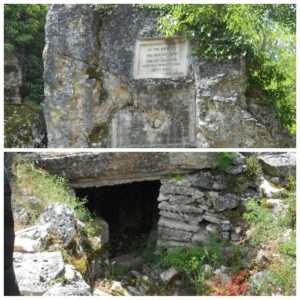5th March 2017 Skopje, North Macedonia
From Wales to Macedonia: Dojran Stories
Each year on 1 March we Welsh celebrate St David’s Day, which is Wales’ national day. Usually we present facts promoting Wales, about tourism, trade, or creativity. Probably many of you know that the World’s first £1 million cheque was signed in Cardiff, or that canned beer was invented in Wales.
Probably many of you don’t know that there is a military connection between Wales and Macedonia dating from the period of First World War. It is the usual war story involving a battle, heroism and awards.
Early in the morning on 18 September 1918, the Welshmen of the 67th Brigade from the 22nd British Infantry Division, went over the top to assault the Bulgarian positions in the area of what is known locally in Dojran as Kale Tepe. The British and French knew this location as the Grand Couronne: it was a position which allowed the Bulgarians to have a clear view over a long distance.
The 67th Brigade was made up of the 11th Battalion Royal Welsh Fusiliers, 11th Battalion Welsh Regiment and the 7th Battalion South Wales Borderers.
The battle started in the early hours. Soon, casualties came. The 11th Bn Royal Welsh Fusiliers moved forward reaching their first objective in ten minutes having encountered little opposition. Once in position, the lead company came under heavy fire and was strongly counter-attacked.
Casualties mounted, but the first target was reached. The battalion’s two remaining companies advanced against a hilltop on the Bulgarian second line known as The Hilt. Two companies passed through the first belt of enemy barbed wire according to the synchronised timetable and then had to adjust their gas masks.
The assault on the Hilt was fierce. There was strong opposition and only a very few men under Major Curtis were able to reach their target. The battle was with heavy machine guns and mortar fire and quickly rendered all officers casualties. After a few hours in the morning it was obvious that too few men remained to perform the next assault. Arrangements were made to consolidate the position and a line to its right and left. The battalion was to remain in this position until relieved by the 9th Battalion Border Regiment during the night of 19 September. A total of 18 officers and 380 soldiers from the Royal Welsh Fusiliers died.
Things were worse for the 11th Battalion Royal Welsh Regiment. After easily occupying a forward position known as The Fang, they pushed on towards The Knot and The Tassel, which stood on either side of Jumeaux Ravine. Many men were wounded by the heavy machine gun and mortar fire. Of 15 officers and 409 soldiers who had gone into action that morning, only 1 officer and 40 unwounded men remained when they left the line next day. The battalion had lost 14 officers and 369 soldiers.
The Brigade’s third battalion, 7th South Wales Borderers, had the most difficult task – to assault the Grand Couronné (Kale Tepe). They made it as far as part of the lower slopes known as The Rockies. The battalions on the flanks were unable to advance, and the battalion was forced to retire after suffering very heavy losses from machine guns on three sides. The remnants of the battalion, fifty-five people, were collected together by 2nd Lieutenant Stephenson who was slightly wounded himself. Many of the wounded people were left in the field as they couldn’t be retrieved due to the enemy fire on the spot. These included the battalion’s commanding officer, Lieutenant Colonel Daniel Burges, who was to be awarded a Victoria Cross for his part in the action, the citation reading:
‘When still some distance from its objective, the battalion came under severe machine gun fire which caused casualties amongst company leaders. Lieutenant Colonel Burges, though himself wounded, quite regardless of his own safety, kept moving to and fro through his command, encouraging his men and assisting them to maintain formation and direction. Finally, as they reached the enemy’s position, he led them forward through a decimating fire until he was again hit twice and fell unconscious.’
Burges survived the battle, being taken to a dugout behind Grand Couronné by Bulgarian stretcher-bearers. Here he was found a few days later following the enemy withdrawal from Dojran.
Today a memorial plaque is located on the back of Kale Tepe commemorating the brave British soldiers that fought and paid the ultimate sacrifice during the battles fought here between 1916 and 1918.
Only two Victoria Crosses were awarded to British soldiers serving during the Salonika Campaign 1915-1918. Both of these went to soldiers of Welsh units, Lieutenant Colonel Daniel Burges, 7th SWB, and Pte Herbert William “Stokey” Lewis, 11th Welsh.
After the War, Welsh veterans continued to return to Dojran so maintaining the connection. Their last visit was in 1969 and was sponsored by the successor regiment, 1st Battalion The Royal Regiment of Wales. That year veterans, well into their senior years, made the journey through Europe, by bus.
The connection continues and since 2015 is marked by a partnership between Dojran and Penarth, a town on the South Wales coastline. Militarily, Macedonia is partnered with the British Army’s 160th (Wales) Infantry Brigade. It is based in the south Wales town of Brecon, coincidently my own home town. The Regimental Museum of the South Wales Borderers adjoins the 160 Brigade barracks. It houses the French Legion d’ Honour medal which was awarded to the 7th SWB by the overall Commander, French General Franchet d’Esperey, for their heroic action during the battle of Dojran 1918.
My own regiment, 1st The Queen’s Dragoon Guards, a cavalry regiment not infantry, but still proudly Welsh, did not serve on the Salonika Front. But one Sergeant, who was attached to a different unit lost his life there and is remembered on the Colonial Memorial overlooking the Dojran battlefield and the beautiful Commonwealth War Cemetery.
With thanks to Glenn Stennes, retired Canadian Army, and retired Lt Col ‘Sticky’ Whitchurch for helping with the accounts of this story.


i like it.. thank you for information…